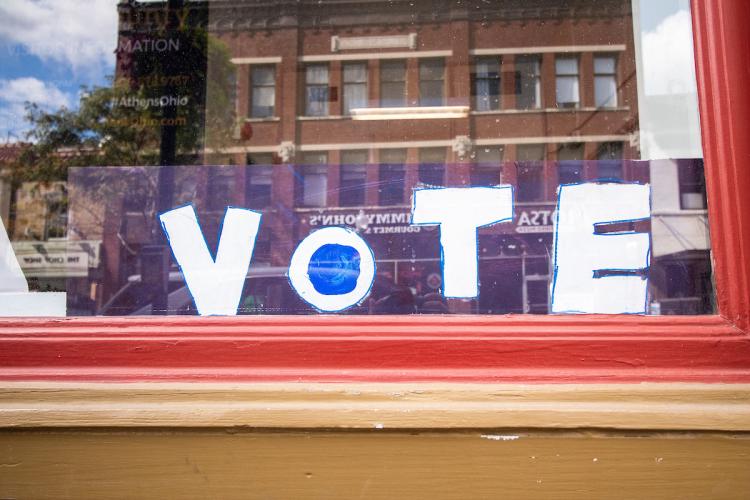
Ohio University voter education efforts paid off in 2020

Ohio University student voting increased nearly 10 percent in last year’s presidential election, rising to 70.6 percent in 2020 from a rate of 60.8 percent in 2016. The data comes from a national report by the Institute for Democracy & Higher Education (IDHE), creators of the National Study of Learning, Voting, and Engagement, or NSLVE.
Ohio University was one of over 200 U.S. campuses designated as a “Voter Friendly Campus” earlier this year by national nonpartisan organizations Fair Elections Center’s Campus Vote Project and NASPA — Student Affairs Administrators in Higher Education.
OHIO students contributed to this increase in voter participation not only by voting, but by engaging and educating other students in the election process. Campus Election Engagement Project Fellows Reese Campbell and Sarah Donaldson worked to register voters, coordinated livestream events, and completed individual projects to support sustained student voter engagement. A team of nine students launched a social media campaign as part of the Power to the Polls Poll Worker Recruiter Program. Through the Campus Vote Project, Kristin Kelley successfully recruited 111 poll workers across all OHIO campus communities, including OHIO students, high school seniors, and community members.
In the run-up to the 2020 election OHIO’s Center for Campus and Community Engagement (CCCE) collaborated with units across the institution to support and promote voter engagement across the University and employed several teams of students working on voter engagement. OHIO integrated voter registration and education into Bobcat Student Orientation, Graduate Student Orientation, and Learning Community lesson plans, hosted outreach events, created a civic engagement portal, coordinated with regional campuses, and provided voter information and resources via a Civic Engagement website.
“Ohio University students, faculty and staff have worked hard to make sure their voices and those of their peers are heard,” Ohio University Dean of Students Patti McSteen said. “Voting is a critical part of being an active, engaged citizen and I’m proud that efforts to get students to the polls are paying off.”
“We know Bobcats voted in 2020 in record numbers. This increase in voter turnout among our student population is a testament to the incredible civic engagement and voter education efforts of our students, and our faculty, who are often the most consistent communicators with students about ever-changing voting conditions and deadlines,” said Mary Nally, director of the Center for Campus and Community Engagement. “When you consider that all this civic engagement and voter education activity took place at a time when most of our students were learning remotely, it’s even more remarkable.”
One of those students was Maxeen Ramlo, a senior mechanical engineering major who helped recruit poll workers ahead of the 2020 election.
“I am thankful for the opportunities I had to engage with this process and to talk and work with my peers,” Ramlo said. “Seeing the gain in statistics of student voters in 2020 has made every hour more worth it. I look forward to seeing the future of voting and civic engagement at OHIO.”
NSLVE is the nation’s largest study of college and university student voting. Institutions must opt into the study, and at this time, nearly 1,200 campuses of all types have done so. The dataset reflects all 50 states and the District of Columbia and includes 49 of the nation’s 50 flagship schools. IDHE uses de-identified student records to ensure student privacy. The 2020 dataset is robust with 8,880,700 voting-eligible students representing 1,051 colleges and universities.
